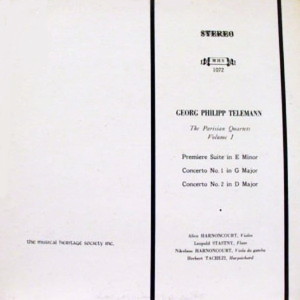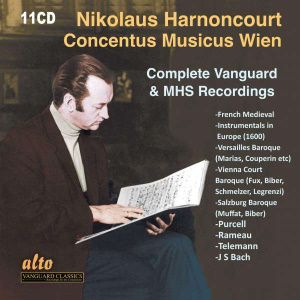 |
1 LP -
MHS 1072 - (p) 1966
|
 |
| 11 LP -
alto ALC 3145 - (p) & (c) 2022 |
|
Georg Philipp
Telemann (1681-1767)
|
|
|
|
|
|
|
|
| The
Parisian Quartets, Volume I |
|
|
|
|
|
|
|
Premiere Suite in E
minor, Twv 43: e1
|
|
23' 21" |
A1 |
| - (Prelude - Rigaudon
- Air - Replique - Menuet - Gigue) |
|
|
|
| Concerto No. 1 in G
Major, Twv 43: G1 |
|
11' 44" |
B1 |
| - (Grave -
Allegro/Largo - Presto - Largo/Allegro) |
|
|
|
Concerto No. 2 in D
Major, Twv 43: D1
|
|
12' 29" |
B2 |
| - (Allegro -
Affettuoso - Vivace) |
|
|
|
|
|
|
|
Alice
Harnoncourt, Violin
(Jacobus Stainer, Absam 1658)
|
|
Leopold
Stastny, Flute (A.Grenser,
Dresden, middle of the 18th
century)
|
|
| Nikolaus
Harnoncourt, Viola da gamba
(Jacobus Stainer, Absam 1667) and
Director |
|
Herbert
Tachezi, Harpsichord (copy
of the Italian
instrument circa 1700, by M.
Skowroneck)
|
|
|
Luogo e data
di registrazione
|
| Casino Baumgarten, Vienna
(Austria) - 1966 |
|
Registrazione
live / studio
|
| studio |
Producer / Engineer
|
-
|
Prima Edizione
CD
|
| alto
- ALC 3145 - (11 lp) - 47' 40" -
(p) & (c) 2022 |
Prima
Edizione LP
|
Musical Heritage Society - MHS
1072 - (1 lp) - 47' 40" - (p) 1966
|
| Note |
| Library of Congress Catalog
No. 70-751714 |
|
|
Notes
|
For many years Telemann
intended to go to Paris. In 1737 he at
last found the time to visit that city,
where he remained for eight months. It was
here that the PARIS QUARTETS werefirst
performed and published.
The first two quartets are called
"Concerto Primo" and "Concerto Secondo,"
and represent the "modern" German school
of composition, circa 1730-1740.
These "Concerti", indeed, the quartets in
general, closely resemble the chamber
concerti of Vivaldi in the manner in which
each of the three instruments are used
individually and collectively. It is not
very likely that Telemann had heard
Vivaldi's chamber concerti (those for
flute, violin and continuo, of for flute,
oboe, violin, bassoon and continuo, some
of which are available on V-15 abd V-12),
since they were not published; nor,
judging from the single set of manuscript
parts, were they widely performed.
Telemann was, however, enpugh in tune with
the progressive spirit of his time to
write his own brand of modern chamber
music, and in so doing he captured the
spirit if not the style of his
contemporary in the South.
The first movement of the Concerto No. 1
in G begins with a slow introduction. The
following allegro combines elements of the
Baroque solo concerto with the newer quadri
(that is, music in which all parts are of
importance and the texture, though
frequently contrapuntal, is not
necessarily imitative in the Baroque -
Bachian - sense). Structurally, the
movement is divided into two almost equal
sections; the second being a slightly
modified version of the first, modulating
from the dominant (D major) to the tonic
of G. The short second movement, largo,
serves as an interlude and transition for
the fast movement in E minor, which
follows.
This movement is virtually a oncerto for
flute with accompanying instrunments.
There is also an interesting affinity
between it and the last movement of Bach's
Fourth Brandenburg Concerto (Bach and
Telemann were close friends for several
years. The latter was, in fact, Godfather
to Emanuel Bach). The following largo is
related melodically to the preceding one,
and like it, serves as a transition to the
next movement, allegro. There is an almost
Vivaldian quality about this movement. The
harmonies, rhythms (particulary in the
flute and violin parts) and some of the
ensemble writing show either a familiarity
with Vivaldi's chamber concerti or a
general familiarity with the more
progressive elements of his music.
Although the chamber concerti were not
published or widely performed in
Telemann's time, many of Vivaldi's
orchestral and solo concerti were in print
and well-known.
The Concerto No. 2 in D begins with a
motif almost identical to that employed by
Bach in his 2nd clavier concerto in C.
Like the "original" (unaccompanied)
version of Bach's concerto, the present
work has a constantly recurring ritornel
/theme), interspersed with contrasting -
solo - passages. Telemann's concerto,
however, utilizes the four instruments as
both soli and tutti, and it is a sure sign
of his ingenuity that one can easily
distinguish when the same instruments are
functioning as a part of the "orchestra"
or in a solo capacity. In the second
movement, Telemann contrasts the sonority
of the viola da gamba with that of the
flute and violin. There is a folk song
quality about this pastoral movement which
doubtless appealed to those who first
heard it as it does to us today.
Unlike the first movement, which is a
concerto for four solo instruments, the
last is virtually a flute concerto with an
occasional obbligato for a solo violin.
The movement is full of interesting
rhythms, and despite the four instruments,
it frequently sounds surprisingly colorful
and varied. Regarding length, intensity,
and diversity of thematic ideas, it is
wothout doubt the strongest movement of
the concerto.
While the first two "Concerti" represented
the "modern" chamber style of the German
composer, the next two quartets represent
the way a "young" composer wrote in the
style of the old-fashioned Italian sonata
da chiesa. For this reason, Telemann
called the third and fourth quartets
"Sonatas".
The difference between the sonata da
chiesa and sonata da camera
was essentially this: The latter was based
on dance movements while the former was
more serious and gad four movements
(slow-fast-slow-fast); the fast movements
being fugal. The slow, though
contrapuntal, were generally less complex.
By Telemann's time, the differences had
became less marked and composers often
referred to their trio sonatas as "sonatas
a tre".
The "Sonata Primo" is an example of a
"modern" composer writing in the style
of the past, albeit, using the
musical language of his own time. For this
reason, the openng movement, while slow
(in the manner of the sonata da chiesa) is
more lyrical than serious more homophonic
than contrapuntal. Onve again the
influence of Vivaldi is noticeable,
especially in the accompaniment played by
the violin and the gamba. In the old
sonata da chiesa, the first and second
movements (and occasionally all four
movements) were frequently based on a
common melodic motif. Such is the case
here: The first, fourth, and seventh notes
of the second movement are identical to
the first three of the first movements.
There is one difference, however, between
the old style sonata da chiesa and
Telemann's second movement. While the
former was nearly always a fugue, the
present movement is fugal without
being a true fugue. In other words,
Telemann wrote in the style of the past
without imitating in all details.
The third movement, andante, is based on
the counter-subject (secondary
melody) of the preceding movement - played
slowly and in a minor key. The rhythm of
the last movement is related to the dance
(specifically the gigue) - shades of the sonata
fa camera within the framework of
the sonata da chiesa. Melodically,
the fugal theme bears a subtle, but
definitive, relationship to the first
movement. More important, however, is the
fact that the first three notes of the continuo
part are identical to those played by the
flute in the first movement, so that we
see how, in his own way, Telemann wrote in
the style of the past while remaining true
to himself and his own time.
Douglas
Townsend
|
|
|
|
Telemann's
Paris QUARTETS for violine,
flute, viola da gamba and
harpsichord are some of his best
and most famous works. He seems
to have had a special fondness
for them, since he made special
mention of them in his
autobiography, which was printed
in 1740 in Mattheson's Ehrenpforte.
The best virtuosi of Paris had
obtained copies of the quartets
and invited Telemann to Paris.
He wrote: "...the admirable
manner in which the Quatuors
were played by the gentlemen
Blavet (cross-flute), Guignon
(violin), Forqueray son (viola
da gamba) deserves to be
descrobed, if this only could be
done by mere words. In short,
they attracted the attention of
the Court and the cuty and
contribuited to the general
esteem in which. I was held
within a short time." These
quartets (of which some are
presented on this record) were
so well received vy Telemann,
while still in Paris, wrote six
more quartets for the same
combination of instruments.
These were published as "Six
Nouveaux Quatuors."
Stylistically, the first six
PARIS QUARTETS consitute a
highly interesting work, since
Telemann demonstrates in them
(in three forms-sonata, suite,
concerto) the prevailing
Italian, French, and German
styles. In spite of this,
however, there is no trace of
any imitation, and the composer
has written in each of the
styles with the sure hand of a
master. As a matter of fact, the
choice of the four solo
instruments is mainly out of
deference to the Franco-German
taste, since at that time the
viola da gamba and the
cross-flute were by no means
popular in Italy, whereas in
Paris they were plainly the
instruments in vogue - togheter
with the violin, which was
coming into fashion. Telemann's
quartets are true soloist music,
in which each of the performers
has to display his full
technical virtuosity as well as
expressiveness in performance,
as each of them is equally
important.
No exact date of composition is
known, but it is assumed these
quartets were written between
1720 and 1730.
Although no autograph score or
parts have yet been found, the
first edition is known to have
been published in 1736 under
Telemann's supervision. It is
this edition which has served as
the basis for the present
recording.
In this recording, only original
instruments were used, i.e., the
violin and the viola da gamba
have the original measurements,
the original bar, especially
made cat gut strings, and are
played with bows dating from the
18th century. The cross-flute,
built by one of the most famous
masters of the 18th century, has
but one key; therefore, all
half-tones are achieved by cross
fingering. Besides the special
sound of the conic boxwood
flute, this has the effect of a
great variety of sound produced
by the individual notes. Thus,
they are given characteristic
features which cannot be
achieved by modern instruments.
The harpsichord is a true copy
of an old one. The strings are
plucked with quills, thus
producing a very clear and
brilliant sound.
The instruments:
- Baroque violin - Jacobus
Stainer, Absam 1658.
- Cross-flute - A. Grenser,
Dresden, middle of the 18th
century.
- Viola da Gamba - Jacobus
Stainer, Absam 1667.
- Harpsichord - copy of an
Italian instrument circa 1700,
by M. Skowroneck.
Nikolaus
Harnoncourt
|
|
Nikolaus
Harnoncourt (1929-2016)
|

|

|
|